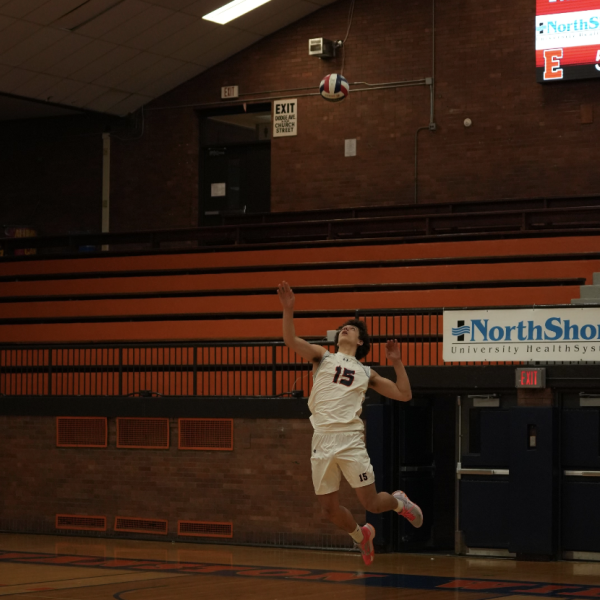Male-dominated culture creates barriers to strength training for girls at ETHS
If a person were to step into virtually any weight room, perhaps the first thing they would notice, aside from the piercing sounds of clanging metal, the all-enduring, sweat-filled aroma and the music blaring at 100 decibels, is that it is a space dominated by boys and men.
“In the weight room, there is still a huge separation between male and female athletes,” says former ETHS strength coach Nancy Harmon.
Harmon, although now at Vernon Hills, has seen this sort of separation occur firsthand in Evanston’s weight room. In fact, she reasons that while the space’s 2019 remodel indeed provided some much-needed improvements, it also counteractively contributed in perpetuating the exclusive environment surrounding strength.
“It’s not like your standard gym. That’s like a collegiate—if not even higher level—quality gym. And if you don’t know how to use the tools in there, what are you supposed to do?” Harmon explains. “And that’s for anyone, male athletes, female athletes, just the general student population.”
So, since girls and women are traditionally shut out from strength training, upgrading the weight room at ETHS has played into sustaining this inequity. However, in her career as a strength coach, Harmon has found that the gender discrepancy in high school weight rooms has nothing to do with female athletes not wanting to lift.
“The culture does have a big influence on whether or not athletes participate in strength training, but ultimately what I’ve found when speaking to female athletes is it’s not that there’s a lack of desire to to be in the weight room,” she notes. “[Men tend to] 100 percent agree strength training is a strong, core portion of being an athlete…it’s not necessarily a staple in [women’s] training.”
According to research published last December in the journal Sports Medicine, incorporating weight training into exercise routines was found to provide equal benefit to both men and women. Although the study was performed on a selection of adults over age 50, its findings almost certainly apply to all age groups.
Yet despite this fact, as Harmon points out, weightlifting tends to play a much more important role in the training of male versus female athletes. At ETHS, evidence for this conjecture manifests itself in the gender ratio of Sports Specific Training (SST) classes being disproportionately male.
“I can’t put an exact number to it, but I’d definitely say a strong majority of [my SST] class is guys,” says junior swimmer Sofia Shewfelt.
As a result of this disparity, Shewfelt has had to deal with instances of feeling like her presence in SST wasn’t entirely desired.
“I don’t feel specifically unwelcome, but there are times where I don’t feel completely welcome in SST. As it is a heavily male-dominated space, it sometimes feels like I’m not intended to be in the class.”
At the same time, Shewfelt also believes that the strength program is aware of the unique unease girls in the class experience, as well as the apprehensions prospective female athletes face when electing whether to take it. She commends the coaches for the work that has already been done, but also wants to see more progress be made towards gender equity in the weight room.
“I think ETHS Strength is already making moves towards a more inclusive environment, like creating female-only after school lifting sessions. This is very valuable, but I think it could be even better if they thought about transitioning this idea to gym classes.”
As with any task, weightlifting requires hard work. In order to become stronger, one must consistently push themselves to perform challenging workouts.
“[The weight room is] a space where you come in and you do the work, and if you do the work, the honest truth is you’re going to see the reward. Don’t do the work and you’re not going to see the reward. It’s very intrinsically fueled,” Harmon asserts.
Intuitively, the benefits—often referred to as “gains”—that strength training can provide serve as the basis for why many athletes lift. While lifting can be, and is often, fun in and of itself, at the end of the day, without any payout, it is unlikely that people would lift at all.
“When you see that outcome as an individual, you’re like, ‘I came in here, and I built this with the tools I was given, and now look what I can do here,’ and it’s just exponentially fulfilling,” Harmon elaborates.
If lifting were easy, everyone would do it; the fact of the matter is that it is not. Because of this, and since boys already outnumber girls in the weight room so starkly, it means that there is something undercutting the motivation of female athletes to strength train. Harmon believes that the root of this problem lies in something lifting culture frequently neglects to recognize: the fact that exercise is more often than not a social activity.
“There’s somewhat of a social component tied to it. You know, ‘Oh, my friend wasn’t coming, so I stopped coming.’ And I think the key is, how do we get [a diverse] group? How do you get [athletes of different genders] to commingle so it’s not like ‘Oh, it’s just my female friends, [but instead] my male friends also are looking for me.’”
According to Insider, Daniel Lieberman, a Harvard paleoanthropologist and author of “Exercised: Why Something We Never Evolved to Do Is Healthy and Rewarding,” says that the best way to encourage people to work out is to have them do it with their friends. This same logic can be applied to the ETHS weight room; the stronger the sense of belonging there is in it, the more likely that athletes will want to come back and lift, day in and day out.
While Evanston definitely still has a long way to go in making the weight room a more inclusive space, under the leadership of head strength coach Mark Feldner, Harmon believes that progress towards this goal will continue to be made in the years to come. As a matter of fact, Feldner was actually her high school strength coach at Niles North, and she credits him as helping foster her love of weightlifting.
“[Feldner] was a huge influence in the reason why I love to lift. He really helped me find my space in a place that made me want to be healthy and like a great athlete,” she recounts.
Additionally, Harmon also credits the community she found in the weight room, particularly amongst other female athletes.
“When I was training, it was also a small group of female athletes who really loved the weight room and found a connection and a kind of family in there,” says Harmon. “We didn’t care that it was a male-dominated space, because we created our own space.”
When push comes to shove, the remodeled weight room exists to serve the greater Evanston student body—not just the football, boys basketball and baseball teams. Regardless of gender, anyone who is willing to work hard, strengthen the community and show up consistently deserves to have a spot cut out for them within the space. Whether or not Evanston athletes agree with this sentiment, Harmon believes that the truth behind it cannot be reiterated enough.
“Everybody’s not going to connect to weightlifting in the same way. You don’t have to lift 400 pounds to be successful in the weight room. Your successes are individualized to you, and that is what I always preached to every athlete I ever got to work with. The expectation is not to be perfect, but each day you come back, you get to decide if you want to improve,” she states. “It’s equally [everyone’s] responsibility to make sure [the weight room] is a space where everyone feels like they can get done what they need to get done.”
Your donation will support the student journalists of the Evanstonian. We are planning a big trip to the Journalism Educators Association conference in Philadelphia in November 2023, and any support will go towards making that trip a reality. Contributions will appear as a charge from SNOSite. Donations are NOT tax-deductible.






Katie Patton • Nov 22, 2021 at 10:59 am
I disagree with the comment made that there is a barrier between genders in the weight room. Girls and boys are given the exact same opportunities to lift and get the instruction that they need in the weight room. Yes, lifting is traditionally male dominated so more men will typically be in the gym but the more you go the more you come to realize that no one (including the guys there) are judging you. If anything they will cheer you on and lift you up. Our strength coaches try very hard to create a positive space for girls to go a lift so I feel that it is unfair to say that they are contributing to this “barrier”. Yes, the weight room is a scary place when you first start going, I was scared too, but I knew that if I wanted to get better I needed to lift. I started coming to the weight room more and more and soon I was very comfortable in there. Anything worth having is going to be scary and is going to require work. This article gives off the wrong message about our training facilities here at ETHS. If you want to lift, go lift. I am positive that you will be welcomed by the coaches and have an equal opportunity to do well in there.